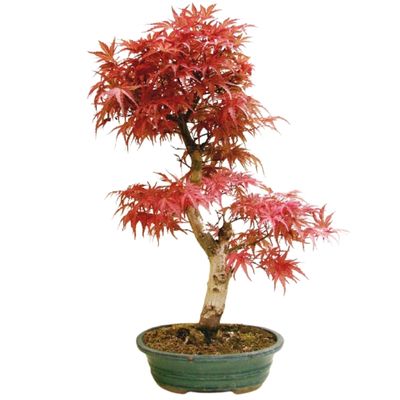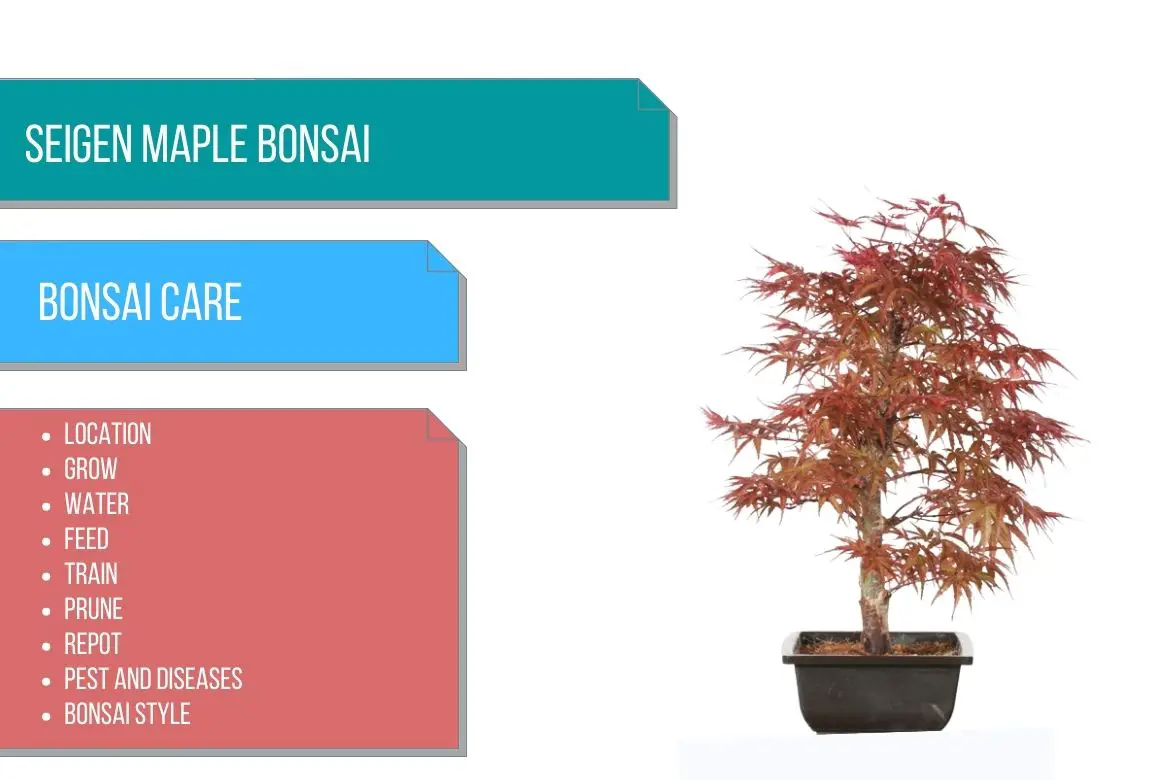
Seigen maple
(Acer palmatum ‘seigen‘)
Country of Origin : Japan
Bonsai Styles : Informal upright, slanting, cascade, twin trunk, group, root-over-rock
Zone : 5 – 8
Siegen maple bonsai (also sometimes known as ‘seigai‘ maple) is one of the most prized Japanese maple varieties. This variety is known for its vibrant coloration.
It is a dwarf tree. This is one of the many red Japanese maple bonsai varieties. Among the red maples, Seigen is less commonly seen.
A small, bright red leaf appears at the opening of the buds, but soon turns deep coral pink as it expands, eventually turning green in color on the midrib of the leaf and orange-red (on the edges).
The foliage of healthy trees turns crimson in the fall. There are other types of Japanese maple trees as well that can be used to make a bonsai. Continue reading 10 best Japanese maples you must try for bonsai and 29 types of Japanese maple trees that can be used to make a bonsai tree.
The tree has a pale gray bark which seems to very faintly take on the color of the foliage. This makes the bonsai even more attractive.
We have also created bonsai care guides for other maple varieties such as – Japanese maple bonsai care and Kiyohime maple bonsai care.

Mostly Seigen maple bonsai is not recommended to bonsai beginners. This is primarily for 2 reasons:
(i) It is thought that this red maple variety will have difficulty growing in temperate climates of Europe and North America.
(ii) Young bonsai specimens you buy from nurseries will also require a lot of work to become good bonsai specimens.
The foliage of the plant has long, elegant lobes. In the spring, the small leaves turn scarlet-red. As summer approaches, the leaves turn into a mix of green and bronze. Orange and yellow colors are predominant in fall.

For all other bonsai tree species you can grow, please read : Types of bonsai trees
Best location keep Seigen maple Bonsai
You should treat these maple cultivators as you would any other cultivar of Acer palmatum.
Seigen maples bonsai will thrive in full sun in summer and spring. However, provide some shade to the tree when the weather gets too hot.
Direct harsh sunlight will destroy the leaves, but a good level of overhead light will improve their color. Continue reading outdoor bonsai tree care.
They can even be left outside in winter. Unlike other red maple variants, they are very hardy and can even survive temperatures as low as 14°F (-10°C). But don’t expose the tree to these temperatures for a long time. Please read how to take care of Japanese maple bonsai in winter season for more details.
These trees are best grown in a temperature range of 30 to 86°F (-1 to 30°C).
It will, however, stop growing if it is exposed to temperatures above 86°F (30°C) for a long period of time.
For more information on how to keep your outdoor bonsai thriving in different seasons of the year, please read seasonal care for bonsai trees.
The foliage is particularly delicate, hence protect the tree from strong winds.
Wind and frost can damage the new leaves in early spring, so be especially careful at that time. Make sure the tree is protected from winter rains.
Refer do bonsai trees need sunlight for more indoor and outdoor bonsai location ideas. Also, refer to sunlight requirements for indoor plants for more indoor gardening ideas.
Propagation Seigen maple
Seigen maple tree can be propagated by sowing seeds in winter. Continue reading about how to grow Japanese maple bonsai from seeds.
Summer is the best time to take softwood cuttings. Continue reading about how to grow Japanese maple bonsai from cuttings.
In the spring or the summer, layer or air layer Seigen maple. Please read how to take care of Japanese maple bonsai saplings and also how to train a Japanese maple seedling into a bonsai.
Watering Seigen maple Bonsai
Regularly water the roots throughout the growing season to prevent them from drying out.
In spring and fall, water once a day; in summer, water twice a day. During the summer, this variety is very thirsty. The watering frequency depends on the climate. Continue reading watering Japanese maple bonsai tree.
Wait for the soil to become slightly dry to the touch in between the watering sessions.
Water sparingly in the winter. Keep the soil moist at all times. Do not keep the soil waterlogged or dry.
Make sure the foliage is regularly misted.
Read watering bonsai tree for more details about immersion technique.
Wiring Seigen maple Bonsai
Before new growth begins in spring, wire the branches when they are bare in the fall. It is also possible to wire partially defoliated branches.
Because the branches are fragile, use aluminum wire. Avoid scarring the branches by wrapping the wire with a wet cloth or raffia.
Check periodically if the branches are biting on the wires.
Wires can be left on the branches for 6 months.
Please read our detailed guide on how to wire a bonsai tree. Also, refer to our detailed bonsai tools guide and how to take proper care of your bonsai tools to know about all the tools of bonsai.
Pruning Seigen maple Bonsai
When to prune Seigen maple bonsai?
Prune the main branches and older twigs in late winter. Thinning of the congested area can be done at this time.
Pruning the seigen maple tree in early and midsummer will promote vigorous growth of new shoots.
It is also possible to perform pruning in spring, two weeks before or after repotting. In spring, new growth should be trimmed to 1-2 pairs of leaves. Continue reading How to prune Japanese maple bonsai. Also, check out how to defoliate Japanese maple bonsai, its a great technique for managing leaf size. It also prevents the inner leaves from getting any disease.
Leave the late-summer growth unchecked to build up vigor for a final trim in early fall.
Prune old knots and spurs down to the shoot or bud.
Refer to how to prune a bonsai tree for more info on best practices and tips and tricks.
Pinching Seigen maple Bonsai
You can pinch the bonsai tree throughout the growing season. Pinch out large leaves to maintain the shape.
Remove two or four true leaves from all new shoots as soon as they appear.
Repotting Seigen maple Bonsai
When to repot Seigen maple bonsai?
Seigen maple can be repotted in early spring or late winter every two or three years.
More mature trees can be repotted in bigger intervals. Repot when the roots are pot bound.
Prune the roots back to the woody sections of the root. Also, remove damaged and circling roots. It is recommended not to remove more than one-third of the roots when repotting.
You can use a free-draining bonsai soil mix. For areas with hard water, use some sphagnum moss. OR, you can use 50:50 ratio of akadama and perlite or lava.
OR
You can also make a soil mix with loam, sharp sand and peat (or compost) in the ration of 1:1:1.
Some good bonsai soil recipes are mentioned in Japanese maple bonsai care article. Please refer to that article for more ideas.
You can read how to repot a bonsai tree to know more about the best guidelines to follow while repotting.
Must Read: Bonsai Soil Recipes
Must read : Choosing the right bonsai container
Feeding Seigen maple Bonsai
A too high nitrogen content will result in green leaves.
Apply a balanced fertilizer during spring and early summer.
Then apply a nitrogen free fertilizer from late summer to leaf fall.
You should not feed your tree during the winter when it is dormant.
A soil acidifier should be applied twice a year in hard-water areas. Please read detailed guide on fertilizing Japanese maple bonsai tree
Read more about bonsai fertilizer and its application.
Diseases and pest of Seigen maple Bonsai
These seigen maple bonsai trees are often attacked by scale insects and aphids. Apply a systemic insecticide when pests are too numerous to be removed manually.
Poorly ventilated or unhealthy trees quickly develop powdery mildew or block spot fungi.
Small caterpillars can occur occasionally. Remove them by hand.
Refer the in-depth guide for bonsai pest and diseases identification and treatment for more details.
Also, read best practices to keep your bonsai pest free.
Seigen maple bonsai care
Direct sunlight and wind must be kept away from delicate foliage. It will damage the leaves.
It is important to slowly acclimatize trees that have come into leaf while under plastic or glass before they are permanently planted outdoors. This will prevent leaf scorch.
To compensate for the low light levels, too much shade may cause the leaves to lose most of their red color, as the plant will try to increase the chlorophyll levels.
The new leaves will retain their color until fall if you provide them with good lighting conditions.
You can keep it outdoors at a place where the tree gets morning sun and in the afternoon it is shaded by a structure or a wall. Read ‘sunlight requirements of bonsai trees‘ for more details and ideas.
During wet winters, keep the soil from becoming waterlogged. Protect from excessive rain and freezing conditions by placing the bonsai container in a shed. Also, Too much dry soil can aggravate the problems caused by pests. Some shoots will die
In midsummer, you can cut through the leaves stalks (petioles) to remove all the foliage if your red maple loses its color. Fresh leaves will appear within a week or two. New leaves will have a reddish tint, will be borne on shorter shoots, and will be smaller. However, this trick should only be applied to healthy red maple bonsai trees and preferably in alternate years.
What to look for when buying Seigen maple Bonsai
Seigen bonsai trees are a little rare.
The surface root formation should be the first thing you look at when selecting a seigen maple specimen.
It should have a natural-looking, radial root system that curves smoothly away from the trunk.
Select a bonsai specimen with a scar-free trunk (at least at the base). Also, the trunk should have natural looking bends.
Often you will see bonsai specimens with scar marks on the upper part of the trunk. Before buying such an example, make sure that you will be able to hide them by carving or designing the bonsai in such a way that the foliage hides the scars.
Additionally, sometimes creating a taper on the upper trunk will require a lot of work along with trying to build a branch structure from the ground up.
Seigen maples require a lot of work, so expect to spend a lot of time on them. Hence, this bonsai is not recommended for beginners.

